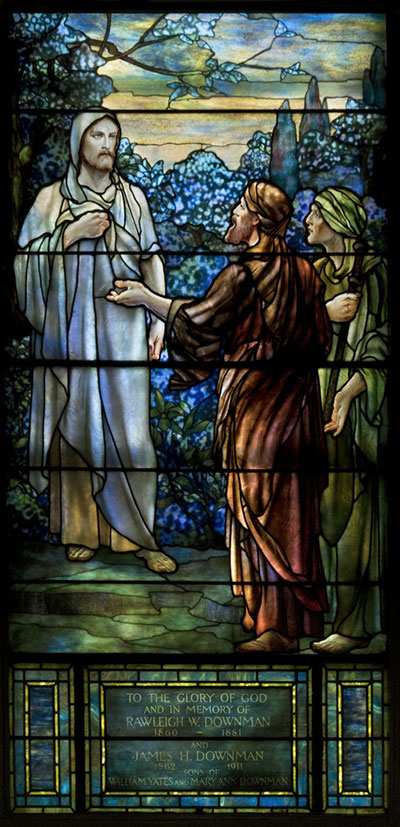
Stained Glass Windows— “Road to Emmaus”, 1912, Tiffany
The story of this window is from Luke 24:13–35. In the image, Cleopas and an unnamed companion encounter the risen Christ on the road to Emmaus about seven miles from Jerusalem. It is Easter Sunday. The men are shocked that anyone could have been in Jerusalem and not known about the events that have happened there. “Abide with us,” they ask the unrecognized stranger, “for it is toward evening, and the day is far spent.” It was not until they offered Him hospitality and He blessed and broke the bread that they recognized Him. He soon disappeared. They got up and returned at once to Jerusalem.
Significant features:
1. Christ‘s robe was done with drapery glass. Glass while molten thrown onto an iron table and rolled into a disk. The glassmaker armed with tongs manipulated the mass and by taking hold of it from both ends like dough and pulling and twisting till it fell into folds.
2. Plated spotted and confetti glass are used to portray the dappled leaves on the trees in the background. Solid glass represents the trees. To make confetti glass, small, irregularly shaped pieces of glass are embedded to the reverse of a sheet of glass.
3. Christ faces toward us, but the men are turned inward, a compositional device that gives the illusion of depth. The faces of the two companions show apprehension as they study the unknown man. The dark brown and green clothing contrasts with the lighter shades used in Christ’s robe.
4. A unique feature of this window is found in the face of Christ. Without backlighting from the sun, the features of the face fade and are unrecognizable, but with the light of day, the features appear, making the identity of the “stranger” apparent.
5. The faces and arms are painted with enamel. It was common to use enamel paint on the faces and arms for a realistic view. Enamels are soft powdered colored glass that is mixed with a medium and painted onto the glass with a brush. When the medium is dry, the glass is placed in a kiln for firing.
We will next look at some of the other parts of the church, starting with the bell.